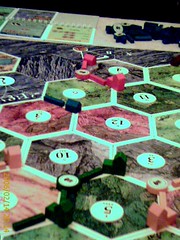Cataan: First Island is based on the classic boardgame "Settlers of Cataan". You play against up to 3 other AI players, gather resources, build roads and settlements, rob each other with "the robber", trade resources with each other in other to do the other activities, and try to accumulate 10 "victory points" to win the island.
The graphics are functional. I have a somewhat difficult time trying to remember which hexes produce which resources, which resources do I have, and what resources do I actually need to build / buy stuff. Not that the game was complicated, just that with FIVE resources to track, and "harvest" is dependent on the dice throw, you never really know what will show up, and what to really go after initially. Thus, trade becomes a very important part of the game, as AI will trade with each other, and you can trade with the AI as well. You can also trade with the "bank" at a severe loss (like ratio of 4:1, though that can be improved by controller more harbors).
The AI also loves to trade you stuff you already have plenty of, so you have to refuse again and again. Sometimes they even propose trades that you couldn't possibly fulfill (i.e. you don't even HAVE that stuff for trade!)
Having never played Settlers of Cataan, the mechanics sounds rather intuitive. One chooses to "build" at the hex intersections of the map. Build settlement first, then a road, and then next player. Then when all players have built, the order is reversed, so that everybody has 2 settlements, and 2 roads. After that, you try to accumulate resources as your settlement determined which hexes you get resources from (the ones touching your settlement). If you expand it to a city (needing some more resources) you get twice the "harvest" when you roll the right numbers.
Each player's dice throw then determines hex(es) will produce resources and thus, who get them, and since nobody will have everything, trade is very important in this game.
Two more items of note... If you roll a 7, you got a 'robber' you can send to steal stuff from your opponents, esp. if s/he has more than 8 of a certain resource, as you get half of that, and s/he gets nothing. Also, you can by "developemental cards", which are like bonus moves you can then reveal at the right time.
All in all, there are a lot of ways to win in this game, and there's sufficient randomness AND enough choices, social or otherwise, that this "port" has maintained the flavor of the original. My main objection is unsufficient reference (there's a tutorial AND an built-in help almanac, but neither really covers any "strategy", just straightforward instructions. It will take a WHILE to really understand which move is beneficial and which move is not, and come up with a proper strategy. Thus, this game is a bit deeper than your typical cellphone game, and even comes with no less than SIX savegame slots. It's good, but it may be too complicated to casual players.
Overall rating: 8 out of 10
Pros: deep strategy, good port from boardgame, decent AI
Cons: not enough help or tutorial, esp. tactics and strategy, some annoying AI tendencies
Verdict: if you like the boardgame, you should love the mobile game... just beware this is quite a bit deeper than your typical mobile game.
About This Place
First started in late 2007, Kasey's Mobile Game Review (then just a regular feature of Kasey's Korner) started as a simul-post between here and IGN. Later I realized there's no reason to post it twice, when I can use the traffic on my own site. so, here we are, in 2010, and the mobile game industry has grown a bit. What do you think?
Subscribe to:
Post Comments (Atom)

![Reblog this post [with Zemanta]](http://img.zemanta.com/reblog_e.png?x-id=c22fb080-a1d9-4796-92a6-d350f6b39418)

No comments:
Post a Comment